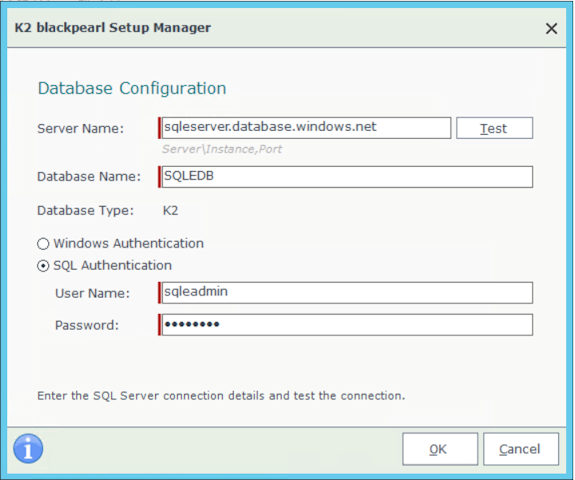Database Configuration
On the Database Configuration page, type in the name of the SQL Server where the K2 database is installed (or if the database does not exist yet, where the database should be created), provide the database name and select the authentication mechanism K2 will use to connect to the SQL database.

| Field | Description |
|---|---|
| Server Name |
Enter the name of the SQL Server where the database will be installed. |
| Database Name |
The default name of the K2 Host Server Database is pre-populated here, and can be altered if this is a new database installation. The default name is recommended for ease of identification. |
What to do on this page
- Enter the name (or Named Instance) for the Database server where the K2 database is located into the field labeled SQL Server.
- Provide and verify the name of the new or existing K2 database.
- Authentication: select Windows or SQL Authentication.
- If Windows Authentication is selected, the credentials of the K2 Service Account is used to establish the connection to the SQL Server.
- If SQL Authentication is selected, provide a username and password that K2 uses to connect to the SQL Server.
- For SQL Authentication Only:
- Enter the User Name and Password.
- Click Test to verify the connection to the database.
- If the test passes, proceed to Step 4.
- If not, the User Name and Password must be corrected before the Setup Manager will allow the installation to proceed.
- Click Next to continue.
Considerations
-
If there are any Database Triggers defined for K2 tables in the K2 database, ensure that the triggers are dropped when performing upgrades. If they are not dropped (or only disabled) during the upgrade process, errors occur. For example, you can use the following command: DROP TRIGGER [K2].[database table] GO
- If you make use of SQL Server AlwaysOn, be sure to point to the correct SQL Server Always on Listener/Instance.
Azure SQL Database
Installing K2 on Virtual Machines that are hosted in Azure and that connect to a K2 database hosted in Azure SQL follows the same basic installation approach as when the K2 database is located in a on-premises SQL Database. During installation, you will point the installer to the database in Azure SQL to allow the K2 installer to perform the necessary configuration for the database.
For information on installing K2 in such an environment, see the topic Non-AD workgroup installation.
Remember to use the database name you created in the Update Configuration step of Install K2 blackpearl with SQL Azure, and use the server name, user name and password used when you created the database.

When using an Azure SQL Database, you must use SQL authentication on the database configuration page of the installer, and provide credentials for an SQL administrative account.